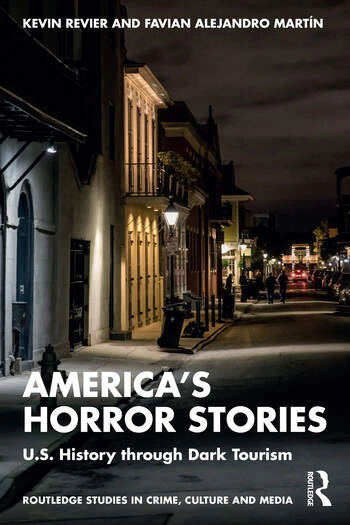Arcadia Professor Investigates US History Through Ghost Tours in New Book
Dr. Favian Martín, associate professor of Criminology and Criminal Justice, and Kevin Revier, a former professor at Arcadia and current assistant professor of Sociology/Anthropology at the State University of New York at Cortland, spent about two years off-and-on traveling the United States together. Their goal was to participate in several ghost tours at sites of racist history to explore how structural racism and slavery in the United States are depicted in dark tourism, which includes visiting places typically associated with death, tragedy, ghosts, and similar topics.

They published their adventures and findings in their new book, “America’s Horror Stories: U.S. History through Dark Tourism,” which was released in late December 2024.
“It really started with us teaching a Preview Course, ‘Dark Dublin,’ for students going to Ireland,” Revier explained. “We both grew up ghost hunting and stuff. Fav grew up by Gettysburg, and I’m from Minnesota, so I grew up going to old barns and fields, largely looking for spirits and the like. We were just really inspired by the history, and how we could think about history more critically.”
During their travels, Martín and Revier visited: Salem, Massachusetts, where a witch panic was sparked by accusations of witchcraft by Tituba, an enslaved woman; New Orleans, Louisiana, which hosted the largest slave trade market; the Myrtles Plantation in Francisville, Louisiana, known as one of the most haunted houses in U.S.; and Gettysburg, Pennsylvania, where the bloodiest battle of the Civil War took place, marking a pivotal moment to end slavery in the nation.
“I think New Orleans kind of caught us off guard a bit,” Martín said. “It would appear in that location they’re more progressive in terms of U.S. history, right? So acknowledging slavery, acknowledging that they were a major slave hub during that time should be a thing. But a lot of those narratives don’t really consider slavery as much as they should.”
“For me, it was seeing how much Confederate memorabilia is available in Gettysburg because a lot of the ghost tourism overlaps with the larger tourist industry,” Revier said. “So you see tons of stores with Confederate belt buckles and all that. I think that was a little shocking to me.”
Martín and Revier both stressed the importance of balancing the fine line between entertainment and education in historical and ghost tours.
“Education’s key, right?” Martín said. “So if you have a good understanding of history and do your research before you go on these tours, I think that might be beneficial, and you can fact-check some of the tour guides.”
“The line can get really blurry, really easily,” Revier explained. “I don’t think dark tourism or ghost tourism is going away, nor do we really want it to. But there are better ways to do it by integrating more of that critical perspective.”
The duo hopes to spend time this summer in Williamsburg, Virginia, to continue their research. While there, they want to examine the ties between ghost tours and American Indians, something they say they have not been able to dive too deep into yet.
“There’s a lot of folklore and ghost stories associated with that area, so we’re going to look at the foundation of the tours and how slavery and American Indians are represented and talked about,” Martín said.


